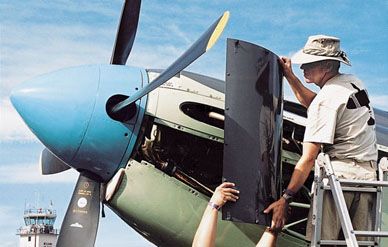The Champ
From the decks of World War II aircraft carriers to today’s airshow circuit-the journey of a Royal Australian Navy Fairey Firefly.
EDDIE KURDZIEL TALKS LIKE HE FLIES--FAST. A FORMER U.S. NAVY AVIATOR accustomed to the cockpits of carrier-based jets, he aims rapid-fire hangar talk at fellow pilots and sunburned airshow-goers alike—and it’s all about his current passion: a beautifully restored Fairey Firefly.
Kurdziel is refreshingly egalitarian, a rare trait in a world of millionaires and their roped-off warbirds. At last September’s Reno International Air Races, attendees could poke their heads into the Firefly’s wheel wells, run their hands along its glossy gray finish, and even climb aboard—an honor seldom granted by a pilot whose aircraft is being considered for the coveted awards at stake at Reno. But the sneaker marks and fingerprints didn’t matter: Kurdziel’s Firefly, which was a Grand Champion at the Experimental Aircraft Association’s AirVenture 2002 fly-in, won both the Rolls-Royce Aviation Heritage Trophy and, perhaps tellingly, the National Aviation Hall of Fame People’s Choice Award.
The Firefly, a British long-range reconnaissance fighter, first flew in 1941 and entered service aboard the aircraft carriers of the British Royal Navy’s Fleet Air Arm in 1943—a year later, Fireflys were used to attack the German battleship Tirpitz. However, it was in the Pacific that the aircraft found its niche. With its four 20-mm cannon and muscular bomb load, the type was used to great effect against Japanese shipping and land targets. After the war, Fireflys were produced until 1956 and were operated by the Royal Dutch, Royal Canadian, and Royal Australian navies; Canadian and British Fireflys saw action during the Korean War. The Firefly, with its powerful engine and a radar operator/navigator in a second seat, had no exact equivalent in the U.S. Navy. Its versatility spawned both night fighter and anti-submarine versions.
Kurdziel began his project more than nine years ago, when he spotted an ad for a “60 percent restored” Firefly. He paid British warbird expert Ray Middleton’s way to Australia to take a look. Middleton approved. Once all the pieces were shipped to the United States, Kurdziel, plus every volunteer he could persuade to help, worked out of a shipping container near Middleton’s Fort Collins, Colorado shop, laboriously matching each component to a Fairey parts list so it could be cataloged for later use.
Kurdziel learned that there are a variety of ways to approach a restoration. Many owners want a reliable aircraft that looks correct but may have modifications under the skin. The alternative is to demand that a restoration be correct throughout. The latter approach is difficult to follow with British aircraft, which use some components not common to U.S. aircraft.
The tradeoffs often start immediately behind the propeller, as with U.S.-owned Hawker Sea Furys, in which the original Bristol Centaurus powerplants are often replaced with widely understood Wright R-3350s—the same engine that powered the Boeing B-29. But a true British restoration extends to the small details, including rivets, bolts, and screws that are completely different from American fasteners.
“Eddie was unique in that he was interested in authenticity,” Middleton says. “And we pushed him that way.” The search for British hardware sent Kurdziel around the world and sometimes required him to borrow pieces from museums so they could be reverse-engineered.
Middleton and fellow restorer Tim Fries engineered a few exceptions for convenience and long-term reliability, such as an improved oil filtration system, but otherwise, the aircraft is as close as it can be to when it was mission-ready in the Australian navy.
Significant work was done to rebuild one of the Firefly’s most distinctive features: Its huge Fairey-Youngman flaps, which made the heavy fighter docile enough to operate from a carrier. Another key feature, pneumatic brakes, is a rarity; many British warbirds flown today have been converted to use hydraulic systems. Kurdziel learned that authenticity required that he master new skills. “It was hard to get used to applying brakes from the stick during run-up instead of pushing the tops of the rudder pedals,” he says.
Kurdziel, who admits he has a Type-A personality, had trouble tolerating the restoration’s sometimes unpredictable pace. “I figured I was paying a penance for something I did in a previous life,” he says. “Maybe I wrecked one.”
Middleton, who has worked on Spitfires and other British aircraft most of his adult life, good-naturedly dressed down his impatient customer. “Ray told me, ‘The owners are just a transient thing. I’ve been maintaining these airplanes longer than you’ve been flying,’ ” Kurdziel says. Further clarity came from Kurdziel’s girlfriend, who asked him if he’d ever considered that the aircraft was more important to the restorers than it was to him. The epiphany was complete—Kurdziel gave in to the Zen of the process and threw away the timelines.
Now, while he’s on the airshow circuit and something goes amiss on the Firefly, Kurdziel knows his place: “I call Ray up and say, ‘Your airplane’s broken. What do I do?’ ”
/https://tf-cmsv2-smithsonianmag-media.s3.amazonaws.com/accounts/headshot/Sotham_photo.jpg)

/https://tf-cmsv2-smithsonianmag-media.s3.amazonaws.com/accounts/headshot/Sotham_photo.jpg)